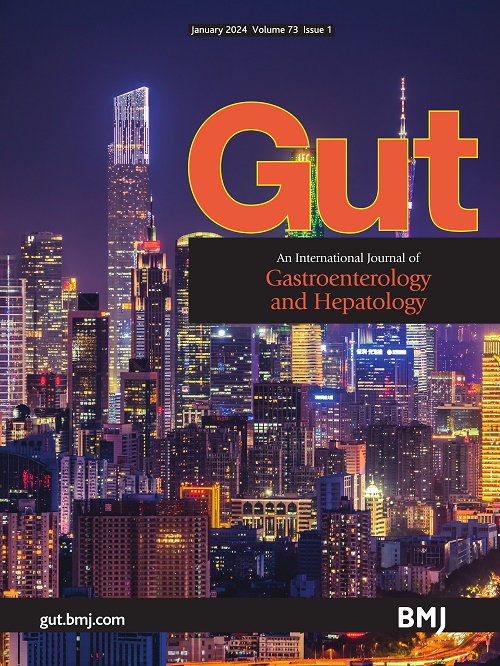在日本全国范围内进行的一项研究表明,在胰液收集中实施置管金属支架的实际影响
IF 25.8
1区 医学
Q1 GASTROENTEROLOGY & HEPATOLOGY
引用次数: 0
摘要
背景:腔内金属支架(LAMSs)越来越多地用于内镜下治疗胰腺积液(pfc),包括壁闭塞性坏死(WON)和胰腺假性囊肿(PCs)。目的评估在全国范围内实施LAMS(2018年在日本获批)对现实世界临床结果的影响。使用全国住院患者数据库,我们在2010年至2023年间在550家医院确定了5885名接受内镜超声(EUS)引导的PFCs治疗的患者。我们检查了治疗时间(lams实施前与lams实施后)与临床结果之间的关系。分别进行多变量logistic和线性回归分析来估计or和系数。研究结果通过来自专科医院的多机构临床队列(n=618)进行验证,该队列具有更详细的临床参数和同期收集的数据。结果在lams前期,3787例患者全部采用塑料支架治疗。2018年之后,在2019年至2023年期间治疗的2098例病例中,LAMS的使用率稳定在50%左右。与LAMS前相比,在LAMS后治疗的患者发生LAMS出血的风险更高(调整OR, 1.81;95% CI: 1.55 - 2.13),但塑料支架没有(调整OR: 0.96;95% CI: 0.74 ~ 1.26)。抢救手术率、住院死亡率和住院时间无显著差异(p < 0.12)。后lams时期与总费用增加有关(调整系数为2813美元;95% CI: 1503 - 4122)。在按PFC类型(WON vs PC)分层的分析中,lams后出血风险与PC的关联似乎比WON更强(p相互作用=0.015),而WON患者在lams后的住院时间更短,总费用更低(p相互作用<0.001)。在验证队列中,证实LAMS的出血风险升高(调整OR, 1.59;95% CI: 0.86 - 2.95,与lams前期相比),但无统计学意义。结论:LAMS的实施与关键临床结果的改善无关,但与出血风险增加和医疗费用增加有关。这些发现不支持在标准临床实践中常规使用LAMS进行eus引导的所有pfc治疗,但可能将其限制在具有明确适应症的WON病例中。由于与向DPC数据库提供数据的医院签订了合同,从DPC数据库获得并在本研究期间进行了分析的数据集尚未公开。如果通讯作者提出合理要求,将从奇妙队列和当前研究中使用的分析方法中获取去识别数据。本文章由计算机程序翻译,如有差异,请以英文原文为准。
Real-world impact of implementing lumen-apposing metal stents for pancreatic fluid collections: a nationwide Japanese study
Background Lumen-apposing metal stents (LAMSs) are increasingly used for the endoscopic management of pancreatic fluid collections (PFCs), including walled-off necrosis (WON) and pancreatic pseudocysts (PCs). Objective To evaluate the nationwide impact of implementing an LAMS (approved in Japan in 2018) on clinical outcomes in real-world settings. Design Using a nationwide inpatient database, we identified 5885 patients who underwent endoscopic ultrasound (EUS)-guided treatment for PFCs at 550 hospitals between 2010 and 2023. We examined the association between treatment period (pre-LAMS vs post-LAMS implementation) and clinical outcomes. Multivariable logistic and linear regression analyses were performed to estimate ORs and coefficients, respectively. Findings were validated using a multi-institutional clinical cohort (n=618) from specialty hospitals with more detailed clinical parameters with data collection during the same period. Results In the pre-LAMS period, 3787 cases were treated exclusively with plastic stents. After 2018, LAMS use stabilised at around 50% among 2098 cases treated between 2019 and 2023. Compared with the pre-LAMS period, patients treated during the post-LAMS period had a higher risk of bleeding with LAMS (adjusted OR, 1.81; 95% CI: 1.55 to 2.13), but not with plastic stents (adjusted OR, 0.96; 95% CI: 0.74 to 1.26). Rates of rescue surgery, in-hospital mortality and length of stay did not differ significantly (p>0.12). The post-LAMS period was associated with increased total costs (adjusted coefficient, US$2813; 95% CI: 1503 to 4122). In analyses stratified by PFC types (WON vs PC), the association of the post-LAMS period with bleeding risk appeared to be stronger for PCs than WON (pinteraction=0.015) and WON patients had a shorter length of stay and lower total costs in the post-LAMS period (pinteraction<0.001). In the validation cohort, the elevated bleeding risk with LAMS was confirmed (adjusted OR, 1.59; 95% CI: 0.86 to 2.95, vs pre-LAMS period), though not statistically significant. Conclusions The implementation of LAMS was not associated with improved key clinical outcomes but was linked to a higher risk of bleeding and increased healthcare costs. These findings do not support the routine use of LAMS for EUS-guided treatment of all PFCs in standard clinical practice but may restrict it to WON cases with clear indications. The datasets derived from the DPC database and analysed during the current study are not publicly available due to contracts with the hospitals providing data to the DPC database. The de-identified data from the WONDERFUL cohort and analytical methods used in the current study will be available from the corresponding author upon reasonable request.
求助全文
通过发布文献求助,成功后即可免费获取论文全文。
去求助
来源期刊

Gut
医学-胃肠肝病学
CiteScore
45.70
自引率
2.40%
发文量
284
审稿时长
1.5 months
期刊介绍:
Gut is a renowned international journal specializing in gastroenterology and hepatology, known for its high-quality clinical research covering the alimentary tract, liver, biliary tree, and pancreas. It offers authoritative and current coverage across all aspects of gastroenterology and hepatology, featuring articles on emerging disease mechanisms and innovative diagnostic and therapeutic approaches authored by leading experts.
As the flagship journal of BMJ's gastroenterology portfolio, Gut is accompanied by two companion journals: Frontline Gastroenterology, focusing on education and practice-oriented papers, and BMJ Open Gastroenterology for open access original research.
 求助内容:
求助内容: 应助结果提醒方式:
应助结果提醒方式:


